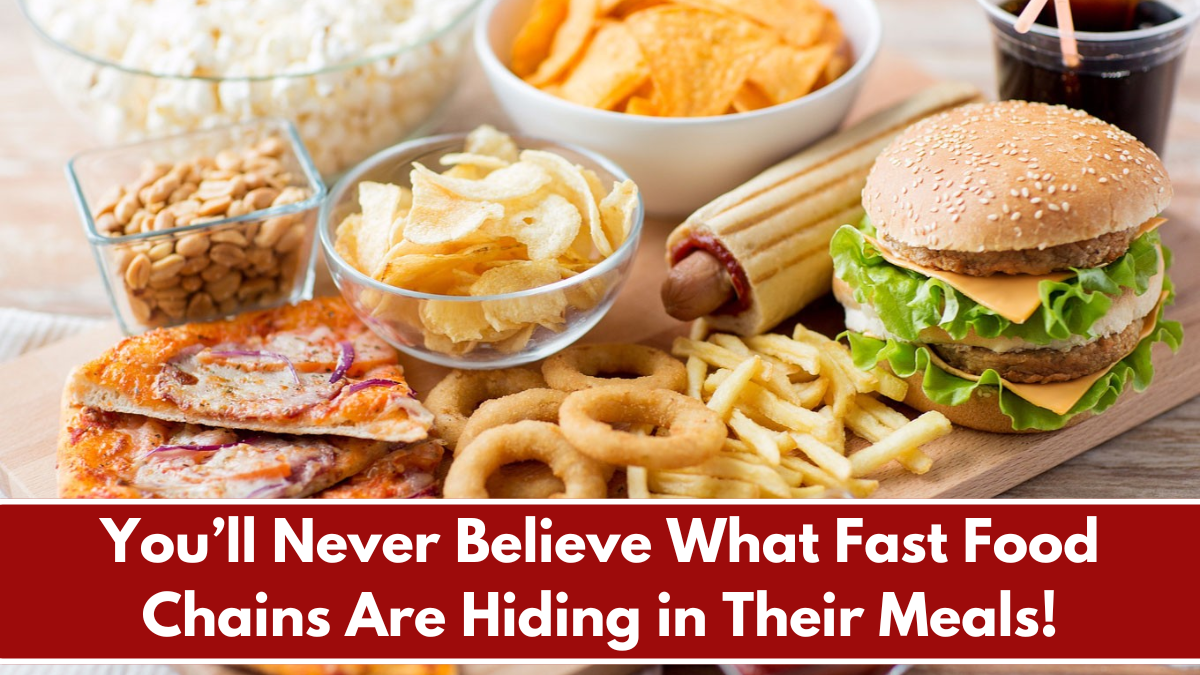The Shocking Truth About Fast Food
Fast food has become an everyday convenience for millions of people worldwide. Whether it’s a quick burger, fries, or a fizzy soda, these meals are cheap, accessible, and satisfying. However, what if you knew the hidden ingredients lurking in these meals—ingredients that could be affecting your health in ways you never imagined?
Fast food chains are not always transparent about what goes into their meals. From chemical preservatives and artificial flavors to hidden sugars and questionable meat sources, the truth behind fast food is shocking. These hidden dangers can contribute to serious health issues, including obesity, heart disease, and digestive problems.
In this article, we’ll uncover the hidden secrets of fast food chains, exposing the ingredients they don’t want you to know about and their effects on your health.
1. The Hidden Chemicals in Your Fast Food
Many fast food meals contain chemical additives and preservatives to enhance flavor, texture, and shelf life. While they may make the food taste better, they come with serious health risks.
Artificial Flavorings and Colorings
Fast food is often loaded with artificial flavors and colors to make it more appealing. Many of these chemicals have been linked to hyperactivity, allergies, and even cancer in high doses. For example:
- Red 40 and Yellow 5, commonly found in sodas and processed cheese, have been associated with behavioral issues in children.
- Monosodium Glutamate (MSG), a flavor enhancer in burgers, fries, and fried chicken, can cause headaches, nausea, and dizziness in some people.
Preservatives That Extend Shelf Life—But at What Cost?
Fast food chains rely on preservatives to keep food fresh for extended periods. Some of the most common include:
- Sodium Nitrate and Nitrites – Found in processed meats like bacon, hot dogs, and sausages, these preservatives have been linked to an increased risk of cancer.
- TBHQ (Tertiary Butylhydroquinone) – A petroleum-based chemical used to prevent oils from going rancid in fried foods. Studies suggest it may have harmful effects on the immune system and liver.
2. The Truth About Fast Food Meat
Fast food chains boast about their “100% beef” burgers and “premium chicken,” but the reality is far from perfect.
Mystery Meat and Fillers
Many fast food chains use meat fillers, binders, and extenders to bulk up their products while keeping costs low. Some of these include:
- Mechanically Separated Meat – A paste-like substance made by forcing animal carcasses through a sieve. It’s often found in processed nuggets and patties.
- Soy Protein and Maltodextrin – Used to increase the weight of meat products without adding real nutritional value.
- Ammonia-Treated Beef (Pink Slime) – A controversial filler made from leftover meat trimmings treated with ammonia to kill bacteria. It has been found in many fast food burgers.
The Use of Antibiotics in Fast Food Meat
Factory-farmed animals are often given antibiotics to promote growth and prevent disease in crowded conditions. The problem? This overuse has been linked to antibiotic resistance in humans, making infections harder to treat. Some fast food chains have pledged to reduce antibiotic use, but many still source their meat from questionable suppliers.
3. The Hidden Sugars and Fats in Fast Food
Sugar Overload in “Savory” Foods
Most people associate sugar with desserts, but many savory fast food items contain shocking amounts of hidden sugar:
- Burger buns, ketchup, and salad dressings contain high-fructose corn syrup, a cheap sweetener linked to obesity and diabetes.
- Some fast food chicken nuggets contain as much sugar as a chocolate bar!
- A medium soda can contain over 40 grams of sugar—more than the daily recommended intake for an adult.
Unhealthy Fats That Harm Your Heart
Fast food is often deep-fried in partially hydrogenated oils, which contain trans fats—one of the most harmful types of fat for human health. These fats:
- Raise bad cholesterol (LDL) and lower good cholesterol (HDL).
- Increase the risk of heart disease and stroke.
- Are commonly found in fried chicken, fries, donuts, and baked goods.
Even when restaurants claim they have eliminated trans fats, many still use palm oil and vegetable oils, which can become toxic when heated repeatedly.
4. What Fast Food Chains Don’t Want You to Know About Their Beverages
Soft drinks and shakes are a huge part of the fast food experience, but they come with their own hidden dangers.
- Sodas are loaded with phosphoric acid, which can weaken bones and lead to osteoporosis.
- Artificial sweeteners in diet sodas, such as aspartame and sucralose, have been linked to metabolic issues and digestive problems.
- Milkshakes often contain more calories than an entire meal, with some large sizes exceeding 1,000 calories!
5. The Psychological Tricks Fast Food Chains Use
Fast food companies use marketing strategies to keep you hooked on their products.
- Addictive Flavor Profiles – Fast food is engineered to be hyper-palatable, making it difficult to stop eating. The combination of fat, salt, and sugar triggers the brain’s pleasure centers, similar to drugs.
- Super-Sized Portions – Many fast food chains encourage customers to buy larger sizes for a small price increase, leading to excessive calorie intake.
- Bright Colors and Logos – Studies show that red and yellow (used in major fast food logos) stimulate appetite and encourage impulse buying.
Conclusion: Should You Quit Fast Food for Good?
While fast food is convenient and tasty, it comes with serious hidden dangers that fast food chains would rather you ignore. From chemical additives and low-quality meat to excessive sugar and unhealthy fats, these meals can have long-term consequences for your health.
Does this mean you should never eat fast food again? Not necessarily—but it does mean you should be informed and make healthier choices. Opt for menu items with fewer processed ingredients, avoid sugary sodas, and be mindful of portion sizes.
If you care about your health, knowing what’s really in your food is the first step toward making better decisions. The next time you visit a fast food restaurant, ask yourself: Do I really know what I’m eating?
FAQ’s:
1. What Are Some of the Most Shocking Ingredients Found in Fast Food?
Fast food contains a variety of hidden ingredients that most consumers are unaware of. Some of the most concerning ones include pink slime (ammonia-treated beef), which is made from meat trimmings treated with ammonia to kill bacteria. Another harmful additive is TBHQ (tertiary butylhydroquinone), a petroleum-based preservative found in fried foods that can cause health issues when consumed in large quantities.
Artificial coloring agents like Red 40 and Yellow 5 are commonly used in sodas and snacks and have been linked to behavioral issues in children. High-fructose corn syrup, found in burger buns, ketchup, and sodas, is another alarming ingredient that contributes to obesity, diabetes, and fatty liver disease. Many fast food sauces and salad dressings also contain propylene glycol, a chemical used in antifreeze, making these seemingly harmless condiments potentially dangerous to long-term health.
2. Is Fast Food Meat Really 100% Beef or Chicken?
While many fast food chains claim their meat is “100% beef” or “premium chicken,” this doesn’t always mean it’s high quality. Many fast food meats contain fillers and extenders like soy protein and maltodextrin to increase the weight of the product without adding nutritional value.
Processed chicken products, such as nuggets, often contain mechanically separated meat, which is made by forcing carcasses through a machine to extract every bit of meat. Additionally, the meat used in fast food is often sourced from factory farms where animals are given large doses of antibiotics to prevent disease, contributing to antibiotic resistance in humans. Even if the label says “real meat,” the quality and processing methods make it far from the natural, fresh meat you would expect.
3. Why Is Fast Food So Addictive?
Fast food is designed to be addictive due to its carefully engineered combination of fat, sugar, and salt, known as the “bliss point.” This combination stimulates the brain’s reward center, triggering cravings and leading to overconsumption. Artificial flavorings enhance the taste, making food more appealing and difficult to resist.
Many fast food items also contain monosodium glutamate (MSG), a flavor enhancer that increases the savory taste of food, making it even more irresistible. The textures of fast food—crispy on the outside and soft on the inside—are also designed to be pleasurable to eat, further reinforcing cravings. Research has shown that consuming fast food regularly can rewire the brain, making people more dependent on these foods for pleasure, much like addictive substances such as nicotine and caffeine.
4. How Much Sugar Is Really in Fast Food?
Many people associate sugar with desserts, but fast food contains high amounts of hidden sugars in places you wouldn’t expect. A medium soda can contain over 40 grams of sugar, which is more than the recommended daily intake for an adult.
Burger buns, ketchup, salad dressings, and even grilled chicken sandwiches often contain high-fructose corn syrup, a cheap sweetener that has been linked to obesity and diabetes. Some fast food chicken nuggets have as much sugar as a chocolate bar due to the use of sweetened batter and sauces. Consuming high levels of sugar from fast food regularly can lead to insulin resistance, weight gain, and an increased risk of developing type 2 diabetes.
5. What Are the Health Risks of Eating Fast Food Regularly?
Eating fast food regularly can have serious health consequences, including obesity, heart disease, and diabetes. The high levels of unhealthy fats, refined carbohydrates, and sodium in fast food contribute to weight gain and increased cholesterol levels. Many fast food meals contain trans fats, which raise bad cholesterol and increase the risk of cardiovascular diseases.
Additionally, excessive sodium can lead to high blood pressure and kidney problems. The lack of fiber in fast food also contributes to digestive issues like constipation and poor gut health. Over time, frequent fast food consumption can increase the risk of stroke, liver damage, and metabolic disorders, making it important to limit intake and prioritize healthier meal options.
6. Are There Any “Healthy” Fast Food Options?
Some fast food restaurants offer “healthier” options, but they are often misleading. Many salads contain high-calorie dressings, cheese, and croutons that add unnecessary fat and sodium. Grilled chicken sandwiches are a better choice than fried ones, but they often contain added sugar and excessive sodium.
Veggie burgers might seem like a good alternative, but many contain processed soy, artificial additives, and preservatives. Even smoothies and yogurt parfaits, which seem healthy, are loaded with sugar from flavored yogurts, fruit syrups, and sweeteners. The best way to eat healthier at fast food restaurants is to choose simple, whole-food ingredients, opt for grilled over fried items, and avoid sugary sauces and dressings.
7. What Are Trans Fats, and Why Are They in Fast Food?
Trans fats are artificial fats created through a process called hydrogenation, which makes oils more solid and shelf-stable. These fats are commonly found in fried foods, baked goods, and margarine, making them a staple in fast food. Trans fats increase the risk of heart disease by raising bad cholesterol (LDL) and lowering good cholesterol (HDL).
They are also linked to inflammation, insulin resistance, and obesity. Although many countries have banned trans fats, some fast food items still contain them in small amounts, especially in processed desserts and deep-fried menu items. Even when restaurants claim to use “zero trans fat,” they often replace them with palm oil and hydrogenated oils, which still have negative health effects.
8. Are Fast Food Drinks as Harmful as the Meals?
Yes, fast food beverages can be just as harmful as the meals themselves. Sodas are loaded with phosphoric acid, which can weaken bones and contribute to osteoporosis. Even diet sodas, which contain artificial sweeteners like aspartame and sucralose, have been linked to metabolic disorders and digestive issues. Milkshakes can contain over 1,000 calories, with sugar levels far exceeding daily recommendations.
Flavored coffee drinks are also high in sugar and unhealthy fats, making them a hidden source of excessive calories. Instead of sugary drinks, a healthier alternative is water, unsweetened tea, or black coffee, which can help reduce sugar intake and avoid unnecessary calories.
9. How Do Fast Food Chains Trick You Into Eating More?
Fast food chains use a variety of psychological tricks to encourage overconsumption. Super-sized portions offer more food for a small additional cost, making it seem like a better deal while leading to excessive calorie intake. Combo deals bundle multiple items together at a discounted price, encouraging customers to buy more than they originally planned.
Bright colors and logos, particularly red and yellow, are strategically used to stimulate appetite and impulse buying. Limited-time offers create a sense of urgency, making people feel pressured to try new items before they disappear. By understanding these marketing tactics, consumers can make more mindful choices and avoid unnecessary overeating.
10. Should I Quit Fast Food Completely?
While quitting fast food entirely may not be necessary, it should definitely be consumed in moderation. Limiting fast food intake to occasional indulgences rather than a regular habit can help reduce health risks. When eating fast food, opting for grilled items over fried, choosing smaller portion sizes, and avoiding sugary drinks can help minimize the negative effects.
Reading ingredient lists and nutritional information can also help make better choices. Preparing homemade meals with fresh ingredients is always the best option, as it allows for greater control over food quality and nutrition. By being mindful of what you eat, you can enjoy fast food occasionally without jeopardizing your health.



